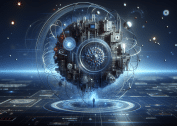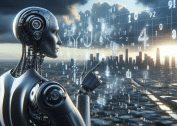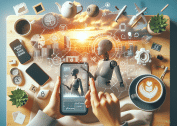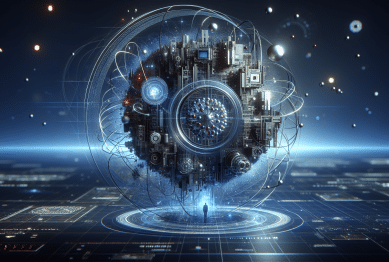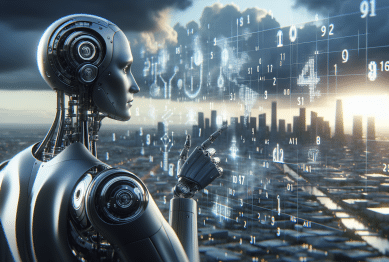Artificial intelligence is changing industries, daily life, and even global priorities. This guide explores how AI-driven technologies are being used, the biggest myths, how they affect jobs, and ethical debates. Discover which developments matter most and what experts suggest about the future of smart machines.
What Makes Artificial Intelligence Powerful
Artificial intelligence stands out as one of the most revolutionary fields in modern technology. AI algorithms are not just capable of processing enormous data sets—they can also identify hidden patterns, predict trends, and fuel entirely new products and services. Industries ranging from healthcare to transportation are finding ways to deploy these technologies for improved efficiency and accuracy. The enormous power of artificial intelligence relies heavily on machine learning, a subset of AI that enables systems to learn and make decisions without being explicitly programmed for every scenario. (Source: https://www.nibib.nih.gov/science-education/science-topics/artificial-intelligence)
One of the reasons artificial intelligence is making headlines globally is its versatility. From personal voice assistants to autonomous vehicles, AI fits almost everywhere. Its strength emerges from processing unstructured data—images, speech, social patterns—and turning it into actionable insight. Companies are leveraging these advances to offer faster, more personalized services. Improved hardware, increased access to cloud computing, and rapid progress in deep learning all contribute to AI’s wide influence in society and commerce. These factors enable researchers and businesses to tackle previously unsolvable challenges.
Another dimension of AI’s appeal is the way it continuously evolves. Newer algorithms and larger data sets expand the boundaries of what machines can do. For instance, natural language processing allows computers to understand human speech. Image recognition helps sort and analyze visuals with accuracy previously impossible for software. These developments allow for smarter security systems, more effective drug discovery, and personalized online experiences. Artificial intelligence adapts, learns, and often surpasses its initial design—leading to a sense of both excitement and uncertainty in the tech world. (Source: https://cmu.edu/ai/programs/what-is-ai.html)
Top Myths and Misconceptions About AI
Misconceptions about artificial intelligence are common, and sometimes they create confusion for both consumers and professionals. A frequent myth is that AI always functions independently and makes decisions without human input. In fact, most successful AI systems require careful oversight, enormous training data, and periodic human guidance. AI does not possess consciousness or intuition; it relies entirely on logic and data-driven learning. Understanding these nuances helps set realistic expectations for what AI can and cannot achieve. (Source: https://www.nist.gov/blogs/taking-measure/which-artificial-intelligence-right-you)
Another widespread misconception is that AI will quickly replace entire human workforces. The reality is much more complex. While automation can handle repetitive or data-heavy tasks, many jobs still depend on critical thinking, emotional intelligence, and human oversight. AI often augments human ability rather than completely replacing it. Some sectors may see rapid transformation, while others adapt AI to support—not supplant—existing teams and processes. Keeping this perspective is vital for understanding industry narratives around artificial intelligence and employment.
Lastly, some believe AI achieves perfect accuracy or objectivity, which can be misleading. AI systems are only as reliable as their design and datasets. Flaws, biases, or inaccuracies within those datasets can skew the results of AI recommendations. This reality highlights the ongoing need for transparency in how models are trained and validated. Recognizing these limitations encourages better design, regulatory oversight, and realistic adoption of AI tools for personal and professional use. (Source: https://ai.google/responsibility/responsible-ai-practices/)
The Impact of AI on Jobs and Economic Growth
The rise of artificial intelligence has sparked both concern and optimism in the world of employment. Rather than eliminating opportunities, AI is transforming the way people work. Recent studies show that automation often changes job duties and creates entirely new categories of employment. For instance, data analysts and machine learning engineers are in high demand, directly because of AI’s expansion. The key challenge for economies will be supporting workers through ongoing skill development and transitions. (Source: https://www.brookings.edu/articles/how-artificial-intelligence-is-transforming-the-world/)
While certain repetitive roles may decrease, jobs that require critical thinking, creativity, and human empathy remain essential. AI excels at pattern recognition and data-driven tasks but struggles with nuance or emotional complexity. Some sectors, such as healthcare or education, increasingly combine AI tools with human expertise to deliver better outcomes. Economic growth can accelerate where organizations invest in training, upskilling, and collaboration between people and machines. Preparing for this future involves new strategies for lifelong learning and flexible career planning.
AI-powered automation also opens the door for new entrepreneurial ventures. Many small businesses now use AI-driven insights to streamline logistics or understand customer needs. As these technologies become more accessible and affordable, they can level the playing field between large corporations and emerging startups. In the long term, AI could lead to higher productivity, new kinds of business models, and greater innovation across industries. The ability to adapt will be vital for economic resilience in an AI-driven age. (Source: https://www.weforum.org/agenda/2022/05/future-of-jobs-report-2020/)
Everyday Uses of AI That Might Surprise You
The influence of artificial intelligence reaches far beyond science labs and big corporations. Everyday life is becoming more connected with AI-driven solutions. Smart home devices use natural language processing to understand commands or predict preferences. Smartphones leverage machine learning for voice assistants, photo enhancement, and real-time translations. Even streaming services apply sophisticated algorithms to personalize recommendations, making it easy to find movies or music that align with unique interests.
Healthcare is another area where artificial intelligence is quietly improving outcomes. AI programs assist in detecting early signs of diseases in medical images, interpreting lab results faster, and streamlining patient care. Virtual health assistants, powered by machine learning, provide timely reminders and help users manage daily wellness. These solutions demonstrate that AI is not science fiction—it’s embedded in daily routines and continues to evolve with each new development. (Source: https://www.nih.gov/news-events/nih-research-matters/artificial-intelligence-healthcare)
Many workplaces deploy AI to automate scheduling, process documents, and improve customer experiences. Online platforms use AI to detect fraudulent activities and enhance digital security. AI chatbots offer instant responses to questions, saving time for both users and support teams. As businesses expand automation, workers benefit from greater productivity and fewer manual errors. The reach of artificial intelligence is growing—and so is public curiosity about its ongoing impact.
Challenges and Ethical Questions Facing Artificial Intelligence
Despite its many advantages, artificial intelligence comes with significant challenges. Data privacy, for instance, is a rising concern as AI systems often require large—and sometimes personal—datasets to function. Ensuring that personal rights are protected while innovating responsibly is an ongoing debate. Strong regulations and privacy standards are being developed worldwide, highlighting the need for balance between technological growth and individual rights. (Source: https://ec.europa.eu/info/law/better-regulation/have-your-say/initiatives/12527-Artificial-intelligence-ethical-and-legal-requirements_en)
Another ethical concern tied to artificial intelligence is bias. Because AI systems learn from data, they can inadvertently inherit and reinforce existing social biases. Incorrect data, incomplete samples, or poor design may all affect how AI makes decisions. Efforts are ongoing to develop transparent methodologies and clear accountability for AI use. Technology leaders and researchers advocate for ethical guidelines to minimize negative side effects and build trust with the public.
Large-scale adoption of AI also brings questions about responsibility. Who bears the burden if an AI-powered decision results in harm? Policymakers, engineers, and legal experts continue to debate regulatory frameworks that address both safety and accountability. Some organizations now use ethical review boards and comprehensive audit systems to assess the impact of their AI projects. These measures aim to ensure that innovation does not outpace the ability to safeguard public interests and fairness in society.
What the Future May Hold for Artificial Intelligence
No one can predict with certainty exactly how artificial intelligence will shape the world, but several trends are emerging. Experts suggest that, as technology matures, collaboration between humans and machines will become integral to problem-solving. In fields like climate science, AI analyzes immense climate data sets to help researchers forecast trends and recommend solutions for environmental stewardship. In public safety, AI enhances early warning systems for natural disasters. (Source: https://climate.nasa.gov/news/2756/how-artificial-intelligence-is-changing-climate-research/)
The sophistication of AI-driven automation is expected to increase. Smarter manufacturing lines, more adaptive learning management, and more advanced personal assistants will emerge. At the same time, there is universal agreement among scientists and policymakers that responsible governance is essential. Establishing robust regulations, transparent algorithms, and ongoing public involvement will be necessary to realize AI’s full promise while controlling risk.
As more people and industries adopt AI technologies, digital literacy will play an important role. Understanding the principles of machine learning, data handling, and algorithmic fairness will help users navigate an AI-driven world. The future likely holds more collaboration between disciplines—technology experts, ethicists, lawmakers, and end users working together. The potential is enormous, and continuous learning will help people and societies adapt, shape, and direct artificial intelligence toward positive outcomes.
References
1. National Institute of Biomedical Imaging and Bioengineering. (n.d.). Artificial Intelligence. Retrieved from https://www.nibib.nih.gov/science-education/science-topics/artificial-intelligence
2. Carnegie Mellon University. (n.d.). What is Artificial Intelligence? Retrieved from https://cmu.edu/ai/programs/what-is-ai.html
3. National Institute of Standards and Technology. (2023). Which Artificial Intelligence is Right for You? Retrieved from https://www.nist.gov/blogs/taking-measure/which-artificial-intelligence-right-you
4. Google AI. (n.d.). Responsible AI Practices. Retrieved from https://ai.google/responsibility/responsible-ai-practices/
5. Brookings Institution. (n.d.). How Artificial Intelligence Is Transforming the World. Retrieved from https://www.brookings.edu/articles/how-artificial-intelligence-is-transforming-the-world/
6. NASA Global Climate Change. (n.d.). How Artificial Intelligence is Changing Climate Research. Retrieved from https://climate.nasa.gov/news/2756/how-artificial-intelligence-is-changing-climate-research/



